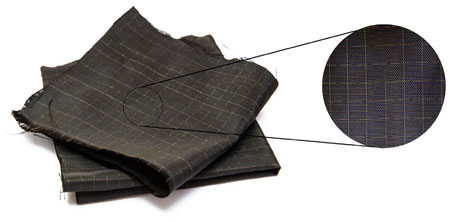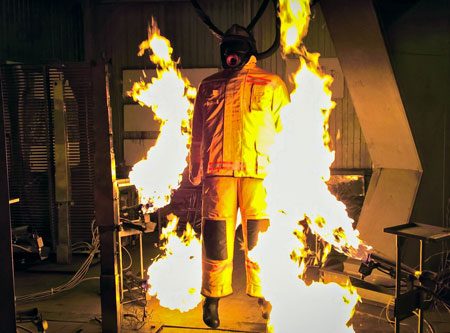| Posted: Mar 17, 2016 |
A unique magnetic material for protective clothes
(Nanowerk News) The personnel of the Non-ferrous Metals and Gold Department of NUST MISIS have developed a cobalt & nickel-based super-resistance material with implanted ultrafine hard-magnetic strontium ferrite particles for the Ministry of the Russian Federation for Civil Defense, Emergency Situations and the Rectification of the Consequences of Natural Disasters (EMERCOM of Russia). The distinctive characteristic of the material is its enhanced refractory properties and frost resistance. Experts note a wide range of possible applications of the material – from the protective clothes of an emergency response worker involved in emergency response to the special clothing used in the Defense industry.
|
 |
| The new aramid fiber textile.
|
|
Today, various subdivisions of the EMERCOM of Russia complete tasks involving fire fighting, rescue operations, and also carry out works related to the safety management in works related to mining operations, including in severe frost conditions reaching -60°C or lower. Up to the present day, protective or functional fibrous materials have been used in the development of various technological tools or protective clothes, whose properties tend to change significantly at higher or lower temperatures.
|
|
For example, during fire fighting in low temperature conditions, water contacting the protective clothes of the fire fighting personnel virtually instantaneously crystallizes, affecting the structure and properties both of individual fibers and the fibrous warp of the protective clothes as a whole. The dissipation processes decrease in the fibrous material, microcracks appear on the surface of fibers or inside them, forming main cracks which lead to dramatic decline in the fibrous materials strength characteristics or even to complete destruction of those fibrous materials.
|
|
The researchers faced the task of developing methods for forming composites and nanocomposites, using functional ingredients that enable enhancing of the dissipativity and the relaxation-deformation processes in fibrous composites at lower temperatures capable of withstanding heat strokes, gradient fields, fast phase changes of water, and cracking in the surface zone.
|
|
At the initial stage of the research, the scientists developed the measurement technique and carried out measurement of strength characteristics of the existing protective materials in the -600°C to +1500°C temperature range, including characteristics such as rigidity, crack resistance, oil-and-petrol resistance, permeability to air, water absorption, wearing capacity, which helped create a new fiber-based makeup for composites and nanocomposites for the manufacture of protective clothes or hose lines used during fire fighting.
|
|
The protection suit for a fireman, manufactured based on this material, is capable of protecting human beings against up to 1200 degree heat (can withstand open fire within 5 seconds), as well as against lower temperatures down to minus 120 degrees.
|
 |
|
The innovative material has undeniable advantage as compared with the traditional material used for the manufacture of Russian-made protection suits for a fireman: The material shows a 5-fold as high temperature resistance and a 3-fold as high flame resistance. The clothes made based on such material are extraordinarily user friendly – a union suit made of the innovative material weighs just a little more than a traditional man’s puffer jacket.
|
|
"Virtually, this is about the creation of the metallurgical technology for the production of fibrous magnetic materials that protect human beings against higher temperatures, magnetic fields and chemical exposure. Comparative analysis with magnetic materials of other companies such as Hitachi (Japan), General Motors (the USA) Ν Magneton (Russia) has shown that the NUST MISIS’s product has nothing directly comparable to it in the world: its properties exceed twice the maximum existing level in the corrosion resistance, working temperature and disruptive strength," says V.P. Tarasov, Head of the Non-ferrous Metals and Gold Department of NUST MISiS, Doctor of Engineering Science, professor, fellow of the National Security Academy. "The present fire-resistance of the material has been reached by introducing a high-melting tungsten filament in the fabric material, which takes on the main energy of a heat stroke. The suit fabric structure is based on aramid fibers covered with a special magnetic alloy."
|
|
The secret of the fabric is based on aramid fibers covered with a special magnetic alloy. The protection suit is like a layer-cake. Another 5 or 7 layers follow the top fire retardant and acidproofing layer. Their task is to form comfortable conditions for human beings. The suit layer closest to the human body generates a strong magnetic field: The NUST MISIS personnel have developed a unique dispersion machine for dispersing particles so that they generate a magnetic field.
|
|
Besides, the magnetic field has a promoting effect on the vitality of the human being. The scientists saw their main task in the development of a material that, as part of a protection suit, enables activation of protective and regenerating functions of the human body in case of exposure to highly toxic substances, highly dangerous biological agents, heat or electromagnetic radiation.
|
|
The research lasted for 5 years. In the meantime, material patenting processes are close to an end, and also joint tests with the EMERCOM of Russia are under way, and the suit performance limits will be determined during those tests.
|
|
"Even now the material demonstrates high performance characteristics – resistance to acids, alkalies, and nonwettabillity. Similar researches are conducted worldwide – in the USA, in particular, in the Stanford University and Stanford Materials and Power Engineering Institute, a cotton-based material has been created, using nanoparticles, which prevents dissipation of 80% of heat, but, nevertheless, our project can be called a breakthrough in the material engineering," concludes Tarasov.
|


